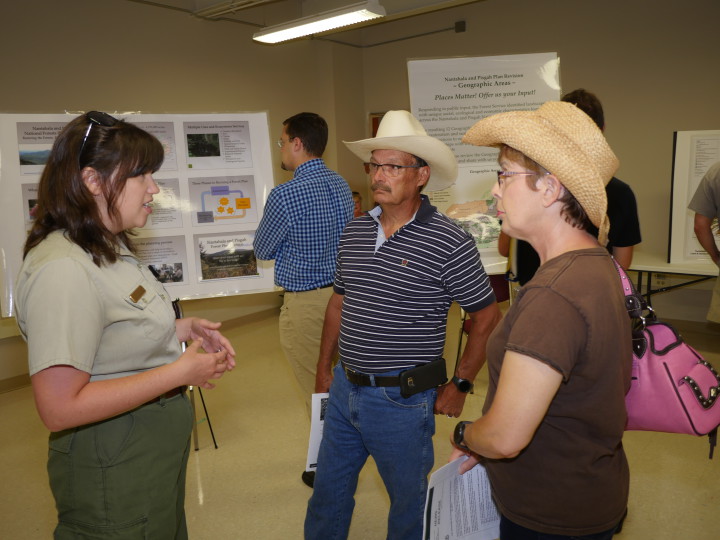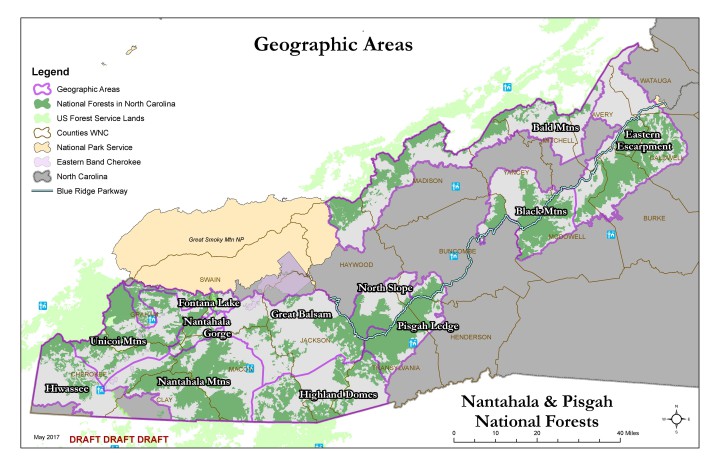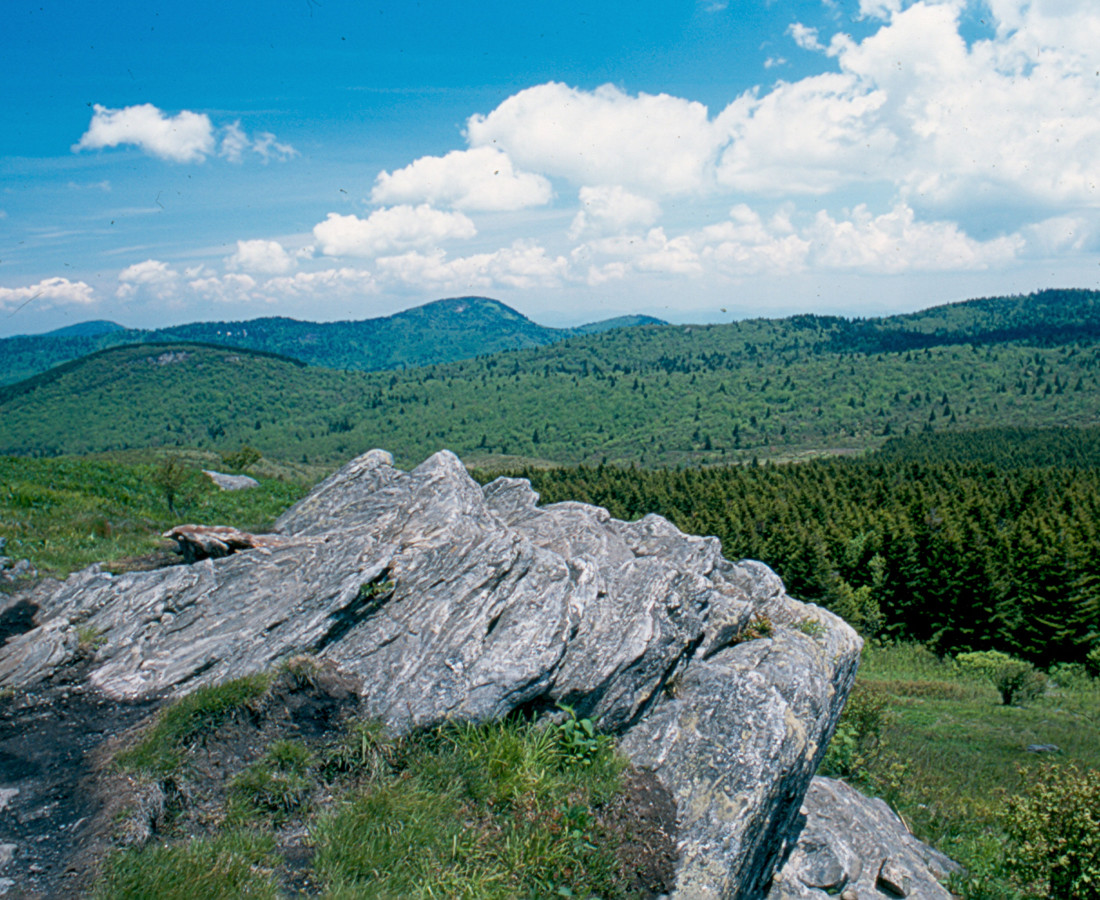For the first time in 23 years, the U.S. Forest Service is revising its management plan for the Pisgah and Nantahala national forests, and some participants in the long, drawn-out process say it could be going better. There’s a lot at stake, because the plan will determine which portions of these public lands can be used for which purposes. That opens the door to conflicts between competing interests, such as environmentalists and timber companies.
In addition to the Forest Service’s public sessions held across the region, the National Forest Foundation, a nonprofit partner of the federal agency, is facilitating a series of stakeholder meetings. Forum members represent diverse interests, some of whom aren’t entirely happy with how things are playing out.
“As of right now, I feel like I’ve wasted a lot of mine and my organization’s time,” says Josh Kelly, a public lands field biologist with MountainTrue, a local environmental group. Calling the forum “dysfunctional” and “a controlled wrestling match,” Kelly says some members don’t seem interested in working together.
And Pryor Gibson, executive vice president of the North Carolina Forestry Association, says the various parties are at a “stalemate.” Gibson, whose organization represents private landowners and the forest products industry, says, “We have some issues.”
Other forum members are more sanguine about the process. Zachary Lesch-Huie, southeast regional director for the Access Fund, says that while there are “some real disagreements” and the process “hasn’t always been easy or fun,” it’s also “actually helped foster new agreement, or at least reduced conflict that really doesn’t help anyone.” The fund represents the interests of recreational climbers.
Lang Hornthal of Root Cause, a sustainable forest products initiative, describes the meetings as “absolutely productive” yet “frustratingly slow.” But as he puts it, “This stuff is complicated.”
And Michelle Aldridge, an Asheville-based Forest Service staffer, doesn’t seem overly concerned. The multiyear process, which began in 2012, is “going well,” she says. “We’ve had a robust public engagement,” with more than 30 meetings so far.
Wide-ranging views
One reason the revision is taking so long is that Nantahala and Pisgah are among the first national forests to use an updated process that tries to maximize community engagement.

After eliciting public input, the agency revises its draft plan and then repeats the cycle. This summer, the Forest Service has been holding a series of regional open houses; the closest one to Asheville is a Tuesday, July 25, event in Mars Hill (see box, “Weighing In”). Others will be in Robbinsville and Brasstown. Agency staff will be on hand to discuss anything pertaining to the plan, but the focus will be on recent revisions designating specific management areas and geographic areas.
The Forest Service relies on public participation to determine how different factions of the community — private citizens and environmental organizations, timber companies and recreational businesses — feel about which uses are appropriate for particular areas. “It just really spans the gamut of anything you can think of,” says Aldridge. “People have been giving us all kinds of input.”
A plan for the land
Blanketing Western North Carolina, the Nantahala and Pisgah national forests stretch across county lines and include many varied landscapes. But this vast expanse of natural beauty isn’t entirely wild.
“The forests don’t manage themselves,” notes Aldridge, and a lot has changed since the last plan revision. “Just think about what was happening in 1994: We were transitioning from cassette tapes to CDs, right?” she reflects, terming the current exercise “overdue.”
Science and technology have seen numerous advances since then. Concepts like climate change and cultural resources have firmly entered the general conversation, and even recreation has evolved. “E-bikes, for example,” Aldridge points out, didn’t exist in 1994.
The current plan revision seeks to incorporate any relevant new information while continuing to balance competing interests, making these public lands a home for both backcountry hikers and commercial loggers.
The overall goal, notes Aldridge, “is to make sure we’re creating a healthy forest that’s as resilient as it can be, to provide the greatest good to the greatest number of people for the greatest amount of time.”
Protecting special areas
The dissension centers on where and to what extent logging should be allowed within the national forests and which areas deserve additional protection.
“If this were the final version,” says Kelly, “we’d be in big trouble.” But the current draft, the field biologist says, is “not universally bad,” citing the division of the forests into areas based on geographic, social and economic characteristics rather than ranger districts and county boundaries as one bright spot.
MountainTrue, for example, lauds the creation of a “special-interest area” in a portion of Big Ivy, but the group contends that places like Daniel Ridge, Cedar Rock Mountain, Upper Santeetlah Creek, Ash Cove, Tellico Bald, Snowball Mountain and Lickstone Ridge also deserve additional protections. In addition, MountainTrue believes such long-distance hiking routes as the Mountains-to-Sea, Bartram, Benton MacKaye and Art Loeb trails should be designated as special corridors, similar to how the Appalachian Trail is handled, to help preserve their character.
“There’s always hope,” notes Kelly.
Responsible logging
Gibson, however, doesn’t want to see harvesting restricted to produce overgrown forest canopies with an underdeveloped floor, or “desert islands of big pretty trees” with “death underneath.”
With a bachelor’s degree in biology and chemistry, Gibson began his career as a builder and real estate developer before moving into politics. According to his organization’s website, he “was a strong ally of the association and the forest products industry during his tenure in the North Carolina General Assembly (1989-90, 1999-2011).”
“We’re not letting enough sunlight hit the floor,” Gibson maintains, explaining that forests should be allowed to grow but also need thinning from time to time in order to maintain a healthy environment. “It’s kind of like the difference between wine and vinegar.”
Without harvesting, says Aldridge, you get “less light hitting the forest floor than you would normally find in a healthy system.” In the past, she explains, nature addressed this via periodic forest fires, but “in the absence of fire, you have more fuel building up. Sometimes you need human intervention to create a more healthy system.”
Besides, Gibson points out, the members of his organization depend on the forests for their living, and overharvesting would be against their own best interest. It takes 27 years for softwoods to reach maturity and more than twice that for hardwoods, he says.
“I know that sounds cosmic,” continues Gibson. “In fact, we were just in Asheville with two schoolteachers, teaching them what sustainable forestry looks like.” And though he says he wants to “preserve the natural forest for my kids and grandkids,” he also argues that commercial interests need a little “leeway” in the national forests.
“I’m a product of the ’70s,” says Gibson. “I’m afraid that my generation has read The Lorax, Dr. Seuss, so literally that they forgot the last part of that sentence: We shouldn’t cut trees ‘irresponsibly.’ They need to add that word.”
The acclaimed 1971 children’s book, whose depiction of corporate greed sparked some controversy, doesn’t draw this distinction.
Special places
Don’t expect to see a final version of the management plan anytime soon, though. In the fall, the Forest Service will incorporate the latest round of feedback into another draft, due out next spring. That version will then be put out for public comment, with the final plan expected in 2019.
The open houses this summer will focus on what Aldridge calls “the new chapters.” Released in May, these revisions divide the forests into different “management areas” as well as a dozen distinct “geographic areas.”

There are three kinds of management areas, dubbed “interface,” “matrix” and “backcountry,” each allowing a different level of activity. The 12 geographic areas are: Bald Mountains, Black Mountains and Eastern Escarpment to the northeast of Asheville; North Slope and Pisgah Ledge directly to the southwest; and Fontana Lake, Great Balsam, Highland Domes, Hiwassee, Nantahala Gorge, Nantahala Mountains and Unicoi Mountains. The idea is to consider the factors unique to each area, Aldridge explains, adding that the previous approach may have been overly broad.
During the open houses, local environmental groups are urging people to talk about the places they love. “Everybody has their own special places,” notes Kelly. Gibson, meanwhile, says he hopes that emotionally driven public comments and social media campaigns don’t end up producing decisions based on “who can tweet the loudest.”
For her part, Aldridge recognizes that various interests are competing for a say in the revisions, but she’s confident that the final version can accommodate those different factions.
“We have a complex forest; we have a lot of diversity,” she says. “This is a landscape of over a million acres. I think there’s space in the national forests to meet all of those needs.”



Before you comment
The comments section is here to provide a platform for civil dialogue on the issues we face together as a local community. Xpress is committed to offering this platform for all voices, but when the tone of the discussion gets nasty or strays off topic, we believe many people choose not to participate. Xpress editors are determined to moderate comments to ensure a constructive interchange is maintained. All comments judged not to be in keeping with the spirit of civil discourse will be removed and repeat violators will be banned. See here for our terms of service. Thank you for being part of this effort to promote respectful discussion.